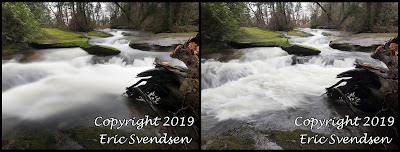 |
| Flash angle can really affect the mood of a shot. |
The main source of light in the above shots was an off camera flash which was tethered (connected via a cable) to a camera to allow regular TTL (through the lens) operation. Essentially it means that you have to point the flash at the subject from whatever angle you want to illuminate it from on the one hand, and shoot it with the camera on the other (both figuratively and literally). The left image was photographed with the flash held below the camera and slightly to the right. The right image was photographed with the flash further to the right and elevated.
It is quite amazing how light and shadow can affect an image. You can take a child's cute toy doll and turn it into Chuckie with lighting alone. If you happen to have a flash which does not have wireless capability, you can pick up a fairly inexpensive cord allowing you to tether it to the camera. You can buy brand name stuff or third party equipment from a variety of suppliers. I have bought stuff from Vello before and found it works well.
One of the best ways to learn about the wonders of flash is to play with it and see what neat kinds of things you can do. Add a few simple refelcters for secondary light and you will be amazed at what you can achieve.
http://www.vellogear.com/ search for off camera TTL flash cable
